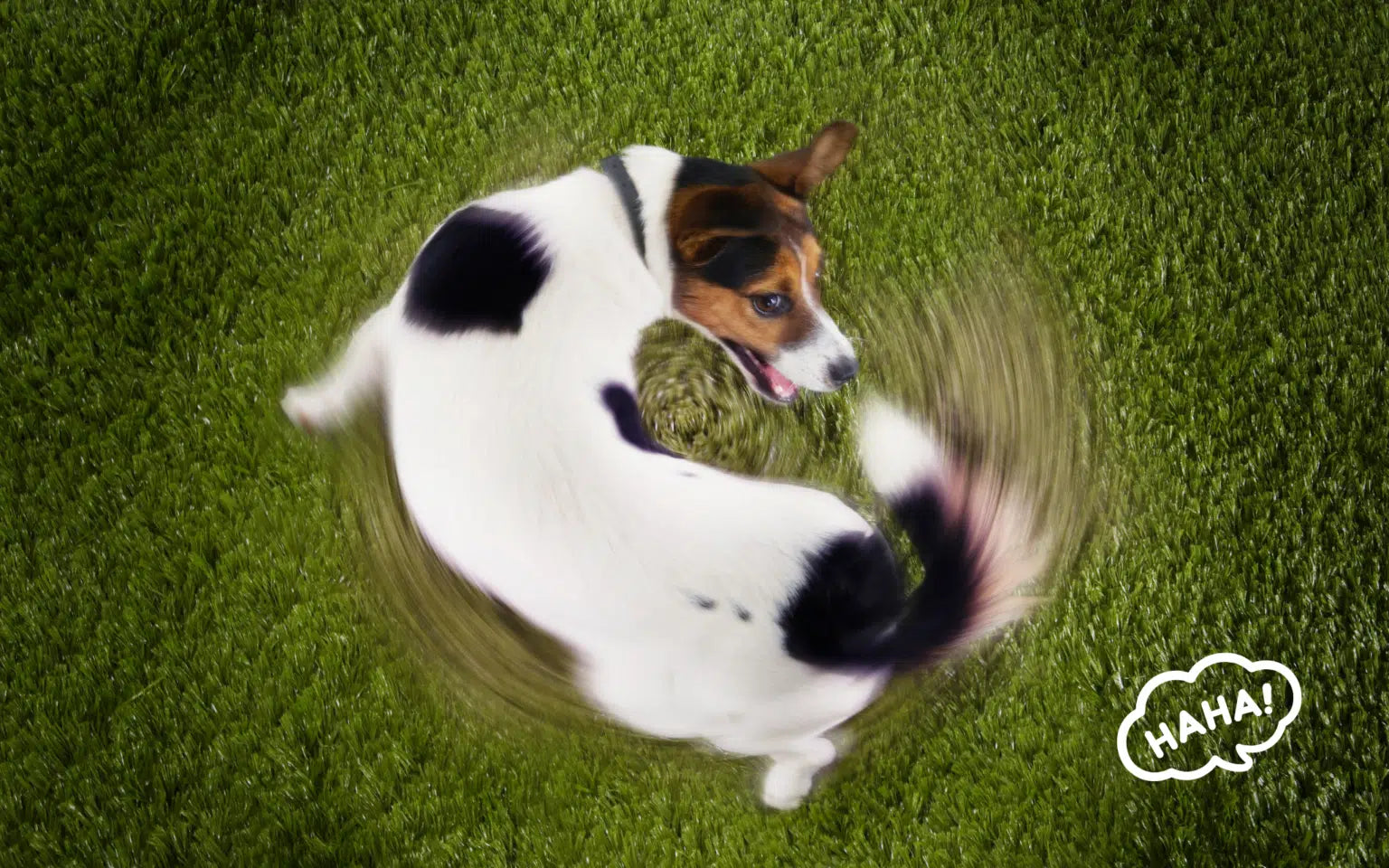There are many different quirky and funny dog behaviours we find entertaining, but did you know they usually have biological reasons behind them? Whether your pooch likes to chase their own tail, gets frequent bouts of the zoomies, or sleeps in strange positions, there’s more to the story. This article explores six common funny dog behaviours and what they mean.
1. Tail chasing
One of the silliest behaviours some dogs like to indulge in is spinning in circles in an effort to catch their own tail. It may seem senseless, but there are actually a myriad of different reasons your dog may enjoy tail chasing:
- Playfulness: This is especially true of puppies, but can apply to any dog. When they feel playful, tail chasing acts as a form of entertainment.
- Excess energy: Some breeds naturally have more energy than others. Particularly high-energy dogs may find tail chasing to be an effective release of energy when they’re in need of some extra exercise. This could be a sign that it’s time for a walk.
- Curiosity: For younger dogs, they may be trying to learn about their own body. Some dogs simply don’t realise that their tail is a part of their anatomy.
- Boredom or attention-seeking: If your dog is lacking mental or physical stimulation, they may start chasing their tail to get your attention or for their own entertainment.
What to watch out for
In most cases, tail chasing is nothing to worry about. However, it can potentially indicate an underlying issue, especially if they seem obsessive, distressed, or uncomfortable:
- Compulsive behaviour: It’s possible for dogs to develop obsessive habits, but they can usually be broken with proper training.
- Medical issues: If your dog feels itchy or uncomfortable from issues like allergies, fleas, or anal gland problems, they may become overly focused on their tail.
- Possible injuries: Your dog may be chasing their tail to tend to an injury. They may also end up causing injuries like sores, irritation, or other wounds from excessive tail biting.
2. Zoomies
Does your dog ever suddenly burst into a full-speed sprint around the house or garden? Well, that behaviour is referred to as the “zoomies”, and it can be very funny and entertaining to watch. Here are some reasons your dog may get a bout of the zoomies:
- Pent-up energy: Similarly to tail chasing, the zoomies offer a way for high-energy dogs and playful puppies to release excess energy.
- Bath time: One of the most common triggers for the zoomies is bath time. After a bath, dogs typically feel a mixture of excitement and relief, and their post-wash sprint is the result. It may also be an effort to dry themselves off and warm up.
- Pure joy or excitement: When your dog feels especially happy or excited, a bout of the zoomies gives them a way to express it. For example, seeing their favourite person, getting a new toy, or exposure to unfamiliar environmental stimuli can all trigger happiness-related zoomies.
- Stress relief: If your dog is feeling anxious or stressed, the zoomies help them release nervous energy. This is similar to how some humans like to exercise to decompress.
What to watch out for
For the most part, zoomies are completely harmless and can actually be a beneficial way for dogs to naturally burn energy and express joy. However, in the interest of safety, intervention may sometimes be necessary:
- Dangerous surroundings: There are some hazards in indoor and outdoor environments to be aware of when your dog starts zooming. For example, indoors, they may crash into sharp objects or fall off furniture. Outdoors, they may run into roads or other off-limits areas.
- Excessive zoomies: If your dog seems to be getting the zoomies far more than usual, it may indicate stress, anxiety, or a lack of exercise. Try to assess and address the underlying reason for these excessive bursts of energy.
- Aggression: While it’s not common, occasionally the overexcitement and excess stimulation that come with zoomies can cause dogs to become rough and nippy, which may be dangerous for surrounding people and dogs.
3. Head tilting
Head tilting in response to auditory stimuli is an adorable behaviour that melts our hearts and puts a smile on our faces, but do you know why your dog does it? Well, not only is this behaviour cute, it also serves a purpose:
- Better hearing: If your dog is trying to pinpoint the source of a sound more accurately, they may do so by tilting their head to adjust their ears.
- Curiosity: When your dog hears an unusual noise or a new, unfamiliar word, they may tilt their head while trying to make sense of it.
- Reading human emotions: Dogs are more attuned to human emotions than many people realise. When studying our facial expressions and tone of voice, they may tilt their head as part of their analysis.
What to watch out for
Occasional head tilting, especially in response to auditory stimuli, is completely normal. However, persistent, excessive head tilting could signal an underlying health issue, such as:
- Ear infections: Frequent head tilting that’s accompanied by redness, scratching, or an unpleasant odour could be indicative of an ear infection.
- Vestibular issues: Inner ear and neurological conditions can cause problems with balance, which may present as persistent head tilting.
4. Sleeping in weird positions
Dogs are notorious for sleeping in some strange positions, from being sprawled out on their backs to curled into a tight ball. In addition to looking cute and funny, each position has a reason behind it:
- On their back: This position helps your dog cool down or stay cool with their belly exposed. They may also raise their paws up in the air. Dogs who sleep this way feel completely calm, safe, and relaxed.
- Stretched out: Some dogs sleep fully stretched out on their bellies, which is referred to as the “superman pose”. This allows them to stay cool, relax, and be ready to jump up on their feet quickly.
- Curled up: This is a classic position that has been passed down from their wild ancestors. It helps your dog warm up and protects their vital organs, so they may choose this position if they want to feel extra secure or cosy.
- On their side: Side sleeping is popular among dogs just like in humans. It’s a sign of relaxation and comfort, and allows them to achieve deep, restful sleep.
What to watch out for
Most sleep positions, even if they seem strange, are normal and comfortable for your dog. However, some sleep positions and behaviours can indicate that something is wrong:
- Always curled into a tight ball: This may be your dog’s favourite position, and that’s completely fine. However, if they literally never sleep stretched out, they may be anxious, cold, or even feeling joint stiffness.
- Head propped up: This is not always a concern, but if your dog has trouble sleeping without their head being propped up on their paws, furniture, pillows, or other objects, it could be a sign of breathing difficulties or other respiratory issues.
- Restlessness: If your dog is restless and unable to stay asleep without frequently switching positions or moving around, they may be feeling some pain, discomfort, or anxiety.
5. Spinning before lying down
Before settling down for a nap or a night of rest, you may notice your dog spins in circles. This behaviour has many ancestral and behavioural reasons behind it:
- Ancestral roots: In the wild, dogs would circle to flatten grass, leaves, or snow, while surveying for threats, allowing them to find a safe and comfortable sleeping spot.
- Comfort: Even on a sofa or a cosy dog bed, spinning around can help your dog find the comfiest spot to settle into.
- Routine or habit: The reason behind your dog’s spinning may be out of pure habit or routine, helping them to unwind and relax.
What to watch out for
In general, pre-rest spinning is normal and natural for dogs. However, if it becomes excessive or you notice that they’re having trouble settling down, it could signal an issue:
- Joint pain or arthritis: If your dog seems to be spinning excessively and struggles to lie down or find a comfortable position, they may be experiencing pain or discomfort.
- Stress: In stressful situations, such as being in an unfamiliar environment, your dog may spin more than usual due to overstimulation or anxiety. If there isn’t a clear reason for your dog to be stressed or agitated, it could signal something underlying.
6. Carrying toys (or chews) around
You may notice that your dog enjoys carrying their favourite toy or chew around, parading it like a prized possession. This behaviour has a few potential explanations:
- Hoarding instinct: Many dogs, particularly those with strong instincts to retrieve, naturally like to collect and carry “valuable” objects like chews or toys.
- Big feelings: When your dog feels strong emotions, such as excitement when you get home, they often channel this energy into a toy (usually accompanied by a wiggly butt and wagging tail).
- Attention seeking: If you tend to give your dog attention when they carry a toy, they will pick up on this and end up doing it more often to engage you.
What to watch out for
In general, this behaviour is nothing but adorable and sweet, so it’s totally fine to let them enjoy their little treasures. However, there are a couple of red flags to be aware of:
- Resource guarding: If your dog growls, snarls, or otherwise aggressively guards their toy, this can signal resource guarding that may require dedicated training.
- Obsessive behaviour: If your dog seems unwilling to put their toy down, even for things like food, rest, or play, this is a sign of obsessive behaviour that could use some extra training.
Final thoughts
Many funny dog behaviours come from instinct, excitement, or attempts to communicate with us. In most cases, they’re completely harmless and very endearing. However, in some instances, they can signal underlying behavioural problems or health issues. When in doubt, observe your dog’s patterns and consult a vet if their behaviour seems excessive, concerning, or unusual. If all seems normal, then you can sit back and enjoy their cute little quirks!





